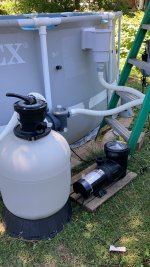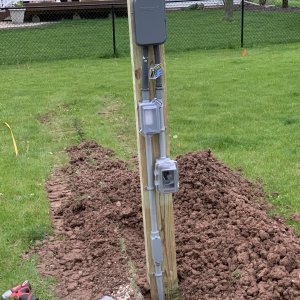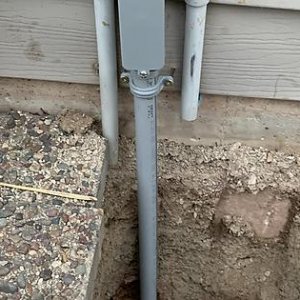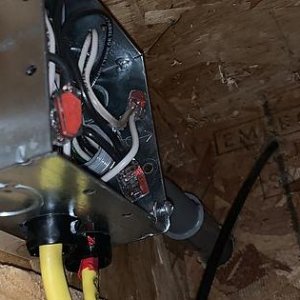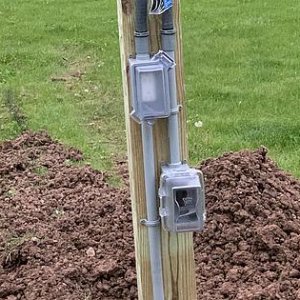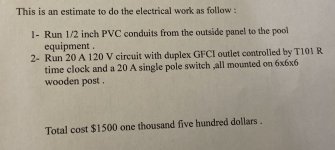All for an Intex pool? Conduit, post, outdoor GFCI outlet is what I have, as the Intex power cord would not reach an outlet at the desired location of the pool in our yard. I dug the trench and hired out an electrician to run the conduit, wires, and outlets.
The conduit ran from the break box downstairs, out under the deck, to a separate set of outlets I also had him install under the deck for whatever I may need them for, and from there down into the ground.
I had him put a quad outlet in. Each duplex receptacle is on a separate 20 A circuit. They were mounted in a heavy duty outdoor rated covered box. This fit the big Intex GFCI plug with some simple sawing on the bottom for the cord.
Unfortunately even this isn't enough outlets. It's
really hard to overinstall outlets. As seen above, the Intex plug takes up an entire duplex, leaving two outlets. Then I got two Intex pool lights and a Aquabot Mini Rover Jr...suddenly I have to switch between the cleaner and the lights!
So, bottom line, don't be afraid to install more outlets, especially if you think you'll get some Intex pool lights (amazing if you want to night swim!) or a robotic pool cleaner.
As to a lighter weight option, if the pool is close enough you can simply plug it into an outlet on the side of your house.
You don't ground the post. At least in the case of mine, there's nothing metallic exposed. If it was, it would be grounded via the ground wire, as all metal electrical cases have to be.
First off, I'm not an expert, if you do anything I suggest hiring out to an electrician if possible, though it sounds tricky. Secondly talk to your local inspector. If you do it yourself, get a permit, they will come out and inspect your work and ensure it's done to code.
So, I did exchange a couple of emails with my local inspector, as I had some plans to upgrade things as
@kellyfair mentioned. The summary I got from my inspector was that Intex pools are considered "storable" pools per the NEC, and as such they are exempted from ground bonding requirements "permanent" pools (hard-wall or inground pools). To meet this exception they have to have certain safety features, among them the GFCI plug end, a long cord (26') to discourage the use of extension cords, and double insulated pumps or other equipment. If you look at your Intex pool pump, the label will say "for use with storable pools only." Regular pool pumps are
not double insulated, and my inspector said that if a regular pool pump or other equipment not rated for use with a storable pool was used, then the pool was now considered permanent and must be bonded as a permanent pool per the NEC.
Now typical hard wall metal pools require a buried bonding wire surrounding the pool, connected to the pool at four locations, plus connected to all pool equipment (motor casings, etc), and connected to a water bonding electrode. Hard wall resin pools are similar except no connection to the pool in four locations since the pool is non-conductive.
Here's where it gets a bit annoying. The Intex pools are made up of a lot of metal tubes, 54 in the case of my pool IIRC, all connected by non-conductive plastic pieces. The inspector said by email that all metal pieces would have to be connected to the bonding grid...so I'd have to make 54 connections to the pool, connecting all the pieces to each other and the surrounding ground bond wire. Again I'd recommend contacting your local inspector, as these types of pools are not well defined in the NEC so I could see some inspectors treating it more like a hard-walled resin pool and not requiring all the tubes to be bonded.
I was planning to upgrade to a variable speed pump, bigger filter, gas pool heater, and a SWCG, but some things happened and plans changed, so that's a task for next year now. I did have some ideas on how to bond the metal tubes starting to form, but hadn't come up with any final plans before our plans changed for this year.


